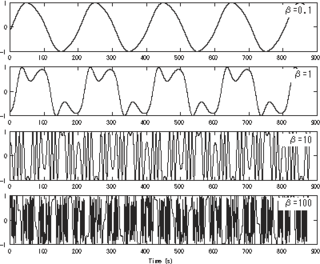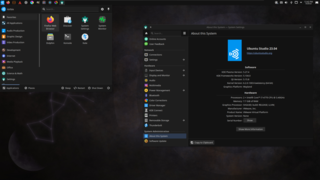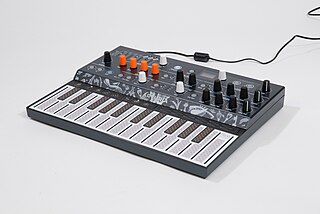Additive synthesis is a sound synthesis technique that creates timbre by adding sine waves together.

Frequency modulation synthesis is a form of sound synthesis whereby the frequency of a waveform is changed by modulating its frequency with a modulator. The (instantaneous) frequency of an oscillator is altered in accordance with the amplitude of a modulating signal.
Subtractive synthesis is a method of sound synthesis in which partials of an audio signal are attenuated by a filter to alter the timbre of the sound. While subtractive synthesis can be applied to any source audio signal, the sound most commonly associated with the technique is that of analog synthesizers of the 1960s and 1970s, in which the harmonics of simple waveforms such as sawtooth, pulse or square waves are attenuated with a voltage-controlled resonant low-pass filter. Many digital, virtual analog and software synthesizers use subtractive synthesis, sometimes in conjunction with other methods of sound synthesis.
A software synthesizer or softsynth is a computer program that generates digital audio, usually for music. Computer software that can create sounds or music is not new, but advances in processing speed now allow softsynths to accomplish the same tasks that previously required the dedicated hardware of a conventional synthesizer. Softsynths may be readily interfaced with other music software such as music sequencers typically in the context of a digital audio workstation. Softsynths are usually less expensive and can be more portable than dedicated hardware.

Fast Light Toolkit (FLTK) is a cross-platform widget library for graphical user interfaces (GUIs), developed by Bill Spitzak and others. Made to accommodate 3D graphics programming, it has an interface to OpenGL, but it is also suitable for general GUI programming.
A rompler is an electronic musical instrument that plays pre-fabricated sounds based on audio samples. The term rompler is a blend of the terms ROM and sampler. In contrast to samplers, romplers do not record audio. Both may have additional sound editing features, such as layering several waveforms and modulation with ADSR envelopes, filters and LFOs.

The Korg OASYS is a workstation synthesizer released in early 2005, 1 year after the successful Korg Triton Extreme. Unlike the Triton series, the OASYS uses a custom Linux operating system that was designed to be arbitrarily expandable via software updates, with its functionality limited only by the PC-like hardware.
Arturia is a French electronics company founded in 1999 and based in Grenoble, France. The company designs and manufactures audio interfaces and electronic musical instruments, including software synthesizers, drum machines, analog synthesizers, digital synthesizers, MIDI controllers, sequencers, and mobile apps.
MIDI Tuning Standard (MTS) is a specification of precise musical pitch agreed to by the MIDI Manufacturers Association in the MIDI protocol. MTS allows for both a bulk tuning dump message, giving a tuning for each of 128 notes, and a tuning message for individual notes as they are played.

LMMS is a digital audio workstation application program. It allows music to be produced by arranging samples, synthesizing sounds, entering notes via computer keyboard or mouse or by playing on a MIDI keyboard, and combining the features of trackers and sequencers. It is free and open source software, written in Qt and released under GPL-2.0-or-later.
Linear arithmetic synthesis, or LAsynthesis, is a means of sound synthesis invented by the Roland Corporation when they released their D-50 synthesizer in 1987.

Ubuntu Studio is a recognized flavor of the Ubuntu Linux distribution, which is geared to general multimedia production. The original version, based on Ubuntu 7.04, was released on 10 May 2007.

A synthesizer is an electronic musical instrument that generates audio signals. Synthesizers typically create sounds by generating waveforms through methods including subtractive synthesis, additive synthesis and frequency modulation synthesis. These sounds may be altered by components such as filters, which cut or boost frequencies; envelopes, which control articulation, or how notes begin and end; and low-frequency oscillators, which modulate parameters such as pitch, volume, or filter characteristics affecting timbre. Synthesizers are typically played with keyboards or controlled by sequencers, software or other instruments and may be synchronized to other equipment via MIDI.

eSpeak is a free and open-source, cross-platform, compact, software speech synthesizer. It uses a formant synthesis method, providing many languages in a relatively small file size. eSpeakNG is a continuation of the original developer's project with more feedback from native speakers.

The Kronos is a music workstation manufactured by Korg that combines nine different synthesizer sound engines with a sequencer, digital recorder, effects, a color touchscreen display and a keyboard. Korg's latest flagship synthesizer series at the time of its announcement, the Kronos series was announced at the winter NAMM Show in Anaheim, California in January 2011.

Harmor is a software synthesizer created by Image-Line Software for the music production program FL Studio. It is available as a demo version within the software; however, it must be purchased separately in order to save projects that contain Harmor instances. Harmor is an upgraded and more elaborate version of its predecessor, Harmless. It was originally released with a 32-bit engine and upgraded to a 64-bit engine in 2013.

Yoshimi is an open-source software synthesizer for Linux. It contains three synthesis engines, using additive, subtractive and wavetable synthesis. Any single patch can use one or all. A kit mode allows a patch to have up to 16 of engine sets to support multi-layered sounds/drum kits. A complete setup or instance can contain anywhere from one to sixty-four patches.

The MicroFreak is a synthesizer manufactured by French music technology company Arturia and released in 2019. Described as a "Hybrid Experimental Synthesizer", it uses 18 digital sound engines (algorithms) to synthesize raw tones. This digital oscillator is then fed into a multi-mode analog filter, giving the MicroFreak its hybrid sounds.











